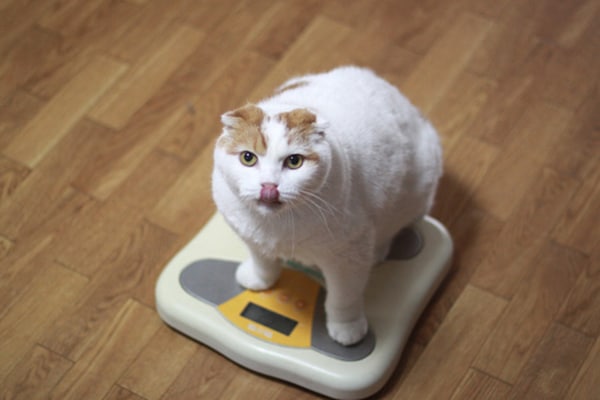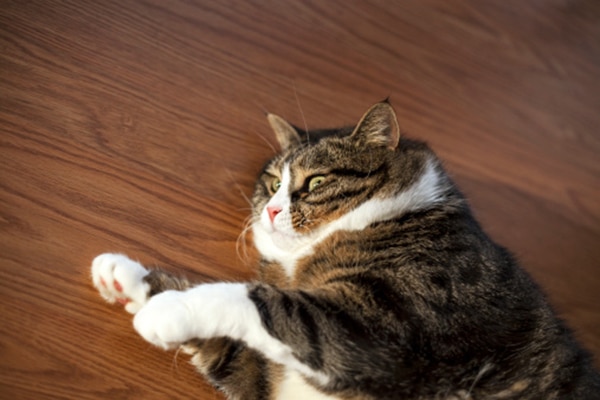All About Cat Diets — How and Why to Put Your Cat on a Diet Safely
The post All About Cat Diets — How and Why to Put Your Cat on a Diet Safely by Jackie Brown appeared first on Catster. Copying over entire articles infringes on copyright laws. You may not be aware of it, but all of these articles were assigned, contracted and paid for, so they aren't considered public domain. However, we appreciate that you like the article and would love it if you continued sharing just the first paragraph of an article, then linking out to the rest of the piece on Catster.com.
According to the Association for Pet Obesity Prevention, 59 percent of cats living in the United States are obese. If you have a fat cat, helping him shed a few pounds will do wonders for his health and might even add years to his life — there’s no better motivation than that to inspire healthy cat diets.
Cat diets are not something to take lightly. Cats are sensitive when it comes to weight loss, so crash diets are a big no-no. “If weight loss is too fast or there is not adequate protein in the diet, the risk of a disease called hepatic lipidosis — a very serious metabolic liver disorder — is a very real danger,” explains Ken Lambrecht, D.V.M., medical director of West Towne Veterinary Center in Madison, Wisconsin.
Here’s how to configure cat diets safely and effectively:
When It Comes to Cat Diets, Work With Your Vet

Your vet will weigh your cat when he comes in for his visit. Photography ©sae1010 | Thinkstock.
“It’s very important for cat owners to work directly with their veterinarians regarding weight-management issues, especially for cats that are significantly overweight,” Dr. Lambrecht says about cat diets. Your vet will help you select the right food and feed the right amounts, as well as monitor your cat’s weight loss to ensure the diet is working. At the first visit, your vet will weigh your cat and also identify his ideal goal weight.
When It Comes to Cat Diets, Aim for Slow Weight Loss
If cats lose weight too fast, they may become very sick. “Weight loss has to be slow and steady, with frequent reassessments by the veterinary team to make sure muscle loss does not occur,” Dr. Lambrecht explains regarding cat diets. The rate of weight loss should not be more than 1 to 2 percent per week.
Choose the Right Diet Cat Food
Cat diets should include foods that are high in proteins and moderate to low in calories. Cats are obligate carnivores, which means they need meat and a good amount of it. Some “diet cat food” contains a lot of carbs, which is not great for weight loss. Most canned foods will have more proteins and fewer carbs than dry foods, but it’s possible to find high-protein, lower-carb dry foods. Again, your vet will help guide you to choose the ideal food for your cat’s weight loss.
Feed the Right Amount — And Don’t Be Fooled by Food Bags
When it comes to cat diets, free feeding is usually not helpful. Measured meals allow you to keep track of how many calories your cat is consuming. But figuring out exactly how much food to feed is tough. “Calorie needs vary according to lifestyle, age and individual cat,” Dr. Lambrecht explains. “Calories are not always clearly labeled. The bag feeding guide often shows too many calories for most cats.” Once again, this is where your vet comes in. Decide on a brand and have your vet calculate how much of that particular food to feed your cat in order to achieve a slow and steady weight loss.
Cut Out — or At Least Cut Back on — Cat Treats
Awwww, no treats? So sad. Commercial cat treats are high in calories and low in nutrition, so there’s no place for them on most cat diets. If you must feed your cat treats, keep them to a minimum and preferably stick to small amounts of high-protein human foods, like tiny bits of cooked chicken or a little bit of scrambled eggs.
Bottom Line: Cat Diets Take Time to Work

A fat cat lying on a hardwood floor. Photography ©ESezer | Thinkstock.
It might take some time, but with diligence, the right cat diets will help your cats drop those pounds and get healthier. “Weight loss can be tricky, but the rewards are huge,” Dr. Lambrecht says. “A cat that feels better, lives longer and acts like a kitten again is a win/win/win.”
Tell us: Have you ever put your cat on a diet? What did you feed him or her? Did you see results?
Thumbnail: Photography ©adogslifephoto | Thinkstock.
This piece was originally published in 2017.
Read more about cat diets on Catster.com:
- The Finicky Cat: Diet Can Help Cats With Urinary Problems
- Ask a Vet: Is There an Ideal Diet for Cats?
- Do Prescription Cat Food Diets Really Work?
The post All About Cat Diets — How and Why to Put Your Cat on a Diet Safely by Jackie Brown appeared first on Catster. Copying over entire articles infringes on copyright laws. You may not be aware of it, but all of these articles were assigned, contracted and paid for, so they aren't considered public domain. However, we appreciate that you like the article and would love it if you continued sharing just the first paragraph of an article, then linking out to the rest of the piece on Catster.com.




Post a Comment